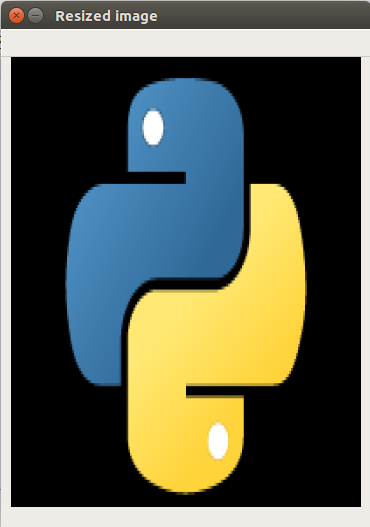

Print('writing to disk'.format(out_f_path)) Img = img.resize((max_px_size, hsize), Image.ANTIALIAS) Hsize = int(float(height_0) * float(wpercent)) As you proceed further, we will discuss resizing with different scale factors and interpolation methods as well. Resize Images in Python With Pillow Import the PIL image class: from PIL import Image Load the image from a file with the open() function: image Image.open. This allows us to pass in the new dimensions in a tuple of length two. Out_f_path = os.path.join(output_folder, out_f_name) resize () Method Image.resize ( size, Tuple representing size resample None, Optional resampling filter box None, Optional bounding box to resize reducinggap None Optional optimization ) To keep things simple, we’ll focus on the size parameter. Not the prettiest but gets the job done and is easy to understand: def resize(img_path, max_px_size, output_folder): Return img.resize(size_new, resample=Image.LANCZOS)Ī simple method for keeping constrained ratios and passing a max width / height. If img_ratio = video_ratio: # image is not tall enough reducinggap Apply optimization by resizing the image in two steps. Width, height = video_size # these are the MAX dimensions The Image module provides a class with the same name which is used to represent a. So after I couldn't find an obvious way to do that here (or at some other places), I wrote this function and put it here for the ones to come: from PIL import Imageĭef get_resized_img(img_path, video_size): The Image.thumbnail method was promising, but I could not make it upscale a smaller image. I was trying to resize some images for a slideshow video and because of that, I wanted not just one max dimension, but a max width and a max height (the size of the video frame).Īnd there was always the possibility of a portrait video. I hope it might be helpful to someone out there! I tried to document it as much as I can, so it is clear. # Enter the name under which you would like to save the new imageĪnd, it is done. # resample filter ->, (default),, etc. #new_width = round(new_height * asp_rat) # uncomment the second line (new_width) and comment the first one (new_height) # NOTE: if you want to adjust the width to the height, instead -> Img = img.resize((new_width, new_height), Image.ANTIALIAS) Img = Image.open(img_path) # puts our image to the buffer of the PIL.Image object You do not need the semicolons ( ), I keep them just to remind myself of syntax of languages I use more often.

In this case, it will adjust the height to match the width of the new image, based on the initial aspect ratio, asp_rat, which is float (!).īut, to adjust the width to the height, instead, you just need to comment one line and uncomment the other in the else loop. If you save the above program as Example.I will also add a version of the resize that keeps the aspect ratio fixed. I am trying to resize an contour to 28×28 pixels and to pass it through. #Make the new image half the width and half the height of the original image The program for resizing and saving the resized image is given below −

To resize an image, you call the resize() method of pillow’s image class by giving width and height. You could either Individually upload them to some resizing tool one by one, or Uhh. This tuple consists of width and height of the image as its elements. Imagine this you have TONS of images in a folder on your computer and you want to resize all of them to certain dimensions (change the height or width).

The Image module from pillow library has an attribute size. The Pillow Handbook contains examples of different operations you can perform on the image. Pillow provides easy-to-setup and usable methods for performing basic image manipulation tasks. We looked at three different ways of resizing images in Python. For this you can use copyMakeBorder() for a pure OpenCV implementation, or since you're using Python you can use numpy.pad(). Most of the digital image is a two-dimensional plane of pixels and it has a width and height. Here's a quick summary of what we learned today. So, after resizing we'll end up with a 1000xN or Nx1000 image (where N<1000) and we'll need to pad it with whatever background color you want on both sides to fill the image to 1000x1000.


 0 kommentar(er)
0 kommentar(er)
